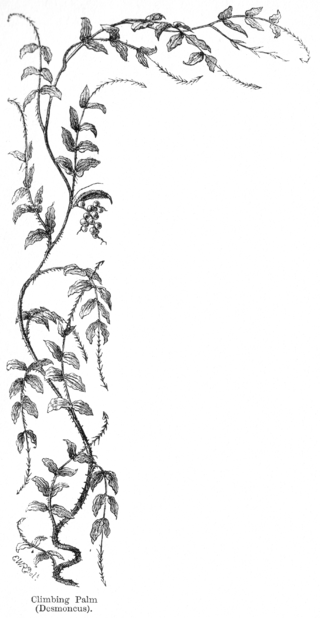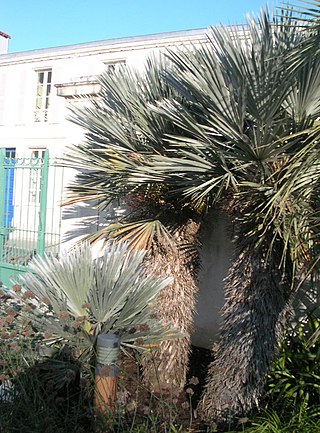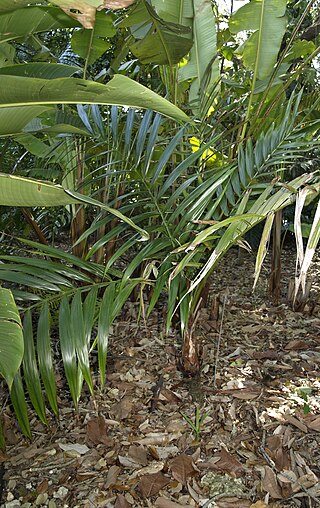
Thrinax is a genus in the palm family, native to the Caribbean. It is closely related to the genera Coccothrinax, Hemithrinax and Zombia. Flowers are small, bisexual and are borne on small stalks.

Zombia antillarum, commonly known as the zombie palm, is a species of palm tree and the only member of the genus Zombia. It is endemic to the island of Hispaniola in the Greater Antilles. Usually found in dry, hilly areas of northern and southern Haiti and the northwest of the Dominican Republic, Z. antillarum is a relatively short fan palm with clustered stems and a very distinctive appearance caused by its persistent spiny leaf sheaths. Threatened by habitat destruction in Haiti, Z. antillarum is a popular ornamental species due to its distinctive appearance, low maintenance requirements and salt tolerance.

Desmoncus is a genus of mostly climbing, spiny palms native to the Neotropics. The genus extends from Mexico in the north to Brazil and Bolivia in the south, with two species present in the southeastern Caribbean.

Chelyocarpus is a genus of small to medium-sized fan palms which are native to northwestern South America. Some are upright trees, while others creep along the ground. Species are used for thatch, to weave hats, stuff pillows and as a source of salt.

Cryosophila williamsii, also known as Lago Yojoa palm or root-spine palm is a species of flowering plant in the family Arecaceae. It is found only in Honduras. It is threatened by habitat loss. Cryosophila williamsii is named in honor of prominent botanist Louis Otho Williams.

Itaya amicorum is a medium-size fan palm that is native to Brazil, Colombia and Peru. It is the only species in the genus Itaya. It was unknown to science until 1972, when it was discovered on the bank of the Itaya River in the Peruvian Amazon.

Schippia concolor, the mountain pimento or silver pimeto, is a medium-sized palm species that is native to Belize and Guatemala. Named for its discoverer, Australian botanist William A. Schipp, the species is threatened by habitat loss. It is the sole species in the genus Schippia.

Trithrinax is a genus of flowering plants in the subfamily Coryphoideae of the family Arecaceae. The name is derived from ancient Greek, where tri means three, and thrinax trident. It was named in 1837 by Carl Friedrich Philipp von Martius, a German botanist and explorer.

Korthalsia is a clustering genus of flowering plant in the palm family spread throughout Southeast Asia. It is a highly specialized rattan with some species known to have an intimate relationship with ants, hence the common name ant rattan. High-climbing and armed with spines, the genus is named for the Dutch botanist P. W. Korthals who first collected them from Indonesia.

Mauritiella is a dioecious genus of flowering plant in the palm family found in South America where it is commonly called buriti. It is named after the similar and closely related genus Mauritia.

Ceratolobus was a dioecious genus of flowering plants in the palm family found in Southeast Asia, commonly called rotan. Its species are now included within the genus Calamus. They are only differentiated from close relatives like Korthalsia, Calamus, and Daemonorops by leaf sheath appendages or inflorescence variations. The Greek genus name combines "horn" and "capsule".

Neonicholsonia is a monotypic genus of flowering plant in the palm family native to Central America. The sole species is Neonicholsonia watsonii. The genus and species names honor George Nicholson, a former curator of the Royal Botanic Gardens, Kew and his successor William Watson.

Leucothrinax morrisii, the Key thatch palm, is a small palm which is native to the Greater Antilles, northern Lesser Antilles, The Bahamas and Florida and the Florida Keys in the United States.

The Coryphoideae is one of five subfamilies in the palm family, Arecaceae. It contains all of the genera with palmate leaves, excepting Mauritia, Mauritiella and Lepidocaryum, all of subfamily Calamoideae, tribe Lepidocaryeae, subtribe Mauritiinae. However, all Coryphoid palm leaves have induplicate (V-shaped) leaf folds, while Calamoid palms have reduplicate leaf folds. Pinnate leaves do occur in Coryphoideae, in Phoenix, Arenga, Wallichia and bipinnate in Caryota.

Corypheae is a tribe of palm trees in the subfamily Coryphoideae. In previous classifications, tribe Corypheae included four subtribes: Coryphinae, Livistoninae, Thrinacinae and Sabalinae, but recent phylogenetic studies have led to the genera within these subtribes being transferred into other tribes. Tribe Corypheae is now restricted to the genus Corypha alone.

Cryosophileae is a tribe of palms in the subfamily Coryphoideae. The tribe ranges from southern South America, through Central America, into Mexico and the Caribbean. It includes New World genera formerly included in the tribe Thrinacinae, which was split after molecular phylogenetic studies showed that Old World and New World members of the tribe were not closely related.

Borasseae is a tribe in the palm subfamily Coryphoideae. The tribe ranges from southern Africa and Madagascar north through the Arabian Peninsula to India, Indochina, Indonesia and New Guinea. Several genera are restricted to islands in the Indian Ocean. The two largest genera, Hyphaene and Borassus, are also the most widespread.

Chuniophoeniceae is a tribe of palms in subfamily Coryphoideae of plant family Arecaceae. The four genera within the tribe are morphologically dissimilar and do not have overlapping distributions. Three of the genera are monotypic, while the fourth genus (Chuniophoenix) has three species.

Trachycarpeae is a tribe of palms in subfamily Coryphoideae of the plant family Arecaceae. It has the widest distribution of any tribe in Coryphoideae and is found on all continents, though the greatest concentration of species is in Southeast Asia. Trachycarpeae includes palms from both tropical and subtropical zones; the northernmost naturally-occurring palm is a member of this tribe. Several genera can be found in cultivation in temperate areas, for example species of Trachycarpus, Chamaerops, Rhapidophyllum and Washingtonia.





















